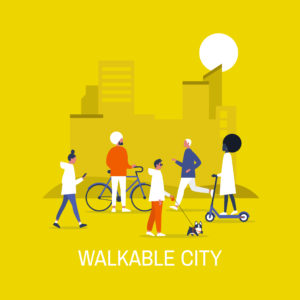Walking Up The Economic Ladder
 Want your kids to have a better life than you do? Move to a more walkable neighborhood.
Want your kids to have a better life than you do? Move to a more walkable neighborhood.
That’s the upshot of a study recently published in American Psychologist. The authors, Shigehiro Oishi, Minkyung Koo, and Nicholas Buttrick, correlated neighborhood walkability with intergenerational upward social mobility. The basic finding: kids who grow up in walkable neighborhoods are more likely to move upward – as compared to their parents – than kids who don’t live in walkable neighborhoods.
The authors begin by noting that “Although upward mobility is generally in decline in the United States …it is easier to get ahead in some parts of the United Sates than in others.” Kids growing up in Pittsburgh, for instance, are much more likely to rise from the bottom 20% (as kids) to the top 20% (as adults) than are kids growing up in Charlotte, North Carolina.
Why would that be? Previous research had identified five factors associated with socioeconomic fluidity for a given area. These are “1) less residential segregation, 2) less income inequality, 3) better primary schools, 4) greater social capital, and 5) greater family stability.” (Social capital is a measure of community participation, including the proportion of people in a given area who vote, volunteer, and otherwise engage in community activities).
Oishi, Koo, and Buttrick accept the “Five Factors” and ask an additional question: does the walkability of a neighborhood also contribute to social fluidity? The authors conducted four different studies to answer this question. Here are some of the top-level findings.
- Comparing 389 commuting zones with walkability ratings from walkscore.com, “showed that upward social mobility was substantially higher in more walkable commuting zones than in less walkable commuting zones.” (r = .390, p<.001)
- But, wait. Maybe it was the Five Factors as opposed to walkability per se. The researchers held the Five Factors constant and found that “walkability explained 11% of additional variance uniquely” beyond the Five Factors. (R2 rose from .41 to .52).
- But, wait. Maybe walkable areas are also more liberal politically – and the liberal policies promote social fluidity as opposed to walkability. Or maybe it’s because walkable areas are healthier and healthier people are more socially fluid. Nope. The researchers held these variables constant (as well as several others). “Overall, walkability was a robust predictor of upward social mobility beyond factors previously used….”
- Why, then would walkability promote social fluidity? One finding is that people have less need for cars in walkable neighborhoods. People without cars can compete effectively for jobs in a wider geographic area.
- Additionally, walkability seems to promote a “sense of belonging” in a neighborhood. The researchers found that these feelings of belonging were “themselves associated with upward social mobility”.
- Does it only work in America? Does this reflect the individualism of America or is it also present in more collectivist societies? The researchers collected data from South Korea, which they describe as a “vertical, collectivist culture”. The finding: “… frequency of walking was indeed associated with a greater sense of belonging, which was in turn associated with upward social mobility.”
This study raises bigger, broader questions as well. Numerous commentators have noted that upward mobility in the United States has declined precipitously over the past 50 to 75 years. Baby boomers may be the last generation to do broadly better than their parents.
This time frame corresponds to the growth of suburbs and our increasing dependence on cars. We can surmise that more people today live in non-walkable areas than they did, say, in 1950. Perhaps this migration explains why upward mobility is declining. As we spread out horizontally, we grow isolated and have less sense of belonging. Though the automobile is a vehicle for geographic mobility, it may well be an obstacle to social mobility.
In the course of writing this article, I discovered a great website: walkscore.com. The site provides walkability ratings on a scale of 0 to 100. For instance, our home in Denver gets a walkability rating of 51. We can walk to some restaurants and are close to some pretty good public transportation. By contrast, our little apartment in Brooklyn gets a walkability score of 99. We could easily live there without a car. Check it out. It may change the way you view your neighborhood.